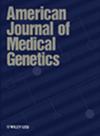fgfr1相关骨红蛋白发育不良的新表型特征
IF 1.7
4区 生物学
Q3 GENETICS & HEREDITY
引用次数: 0
摘要
骨红蛋白发育不良(OGD)是一种罕见的骨骼疾病,由FGFR1的某些变异引起。FGFR1基因编码对轴骨和颅面骨骼成骨至关重要的受体。OGD的主要特征包括颅缝闭合、颅面畸形、牙阻生、根茎缩短和非骨化性纤维瘤。患者可能由于FGF23水平高而出现低磷血症。我们报告了两例OGD患者C . 1141t > C FGFR1变异[p.(Cys381Arg)],最初诊断为Pfeiffer综合征。两人都表现出经典症状以及以前未报道的体征,包括额部温度升高和脚趾重叠。本报告强调区分OGD与类似疾病和扩大临床表型。本文章由计算机程序翻译,如有差异,请以英文原文为准。
New Phenotypic Features in FGFR1-Related Osteoglophonic Dysplasia.
Osteoglophonic dysplasia (OGD) is a rare skeletal disorder caused by certain variants in FGFR1. The FGFR1 gene encodes a receptor vital for osteogenesis in the axial and craniofacial skeleton. Key OGD features include craniosynostosis, craniofacial dysmorphism, impacted teeth, rhizomelic shortening, and nonossifying fibromas. Patients may have hypophosphatemia due to high FGF23 levels. We report two OGD patients with the c.1141T > C FGFR1 variant [p.(Cys381Arg)], initially diagnosed with Pfeiffer syndrome. Both showed classic symptoms as well as signs not previously reported, including elevated frontal temperature and overlapping toes. This report emphasizes distinguishing OGD from similar disorders and expanding the clinical phenotype.
求助全文
通过发布文献求助,成功后即可免费获取论文全文。
去求助
来源期刊
CiteScore
3.50
自引率
5.00%
发文量
432
审稿时长
2-4 weeks
期刊介绍:
The American Journal of Medical Genetics - Part A (AJMG) gives you continuous coverage of all biological and medical aspects of genetic disorders and birth defects, as well as in-depth documentation of phenotype analysis within the current context of genotype/phenotype correlations. In addition to Part A , AJMG also publishes two other parts:
Part B: Neuropsychiatric Genetics , covering experimental and clinical investigations of the genetic mechanisms underlying neurologic and psychiatric disorders.
Part C: Seminars in Medical Genetics , guest-edited collections of thematic reviews of topical interest to the readership of AJMG .

 求助内容:
求助内容: 应助结果提醒方式:
应助结果提醒方式:


